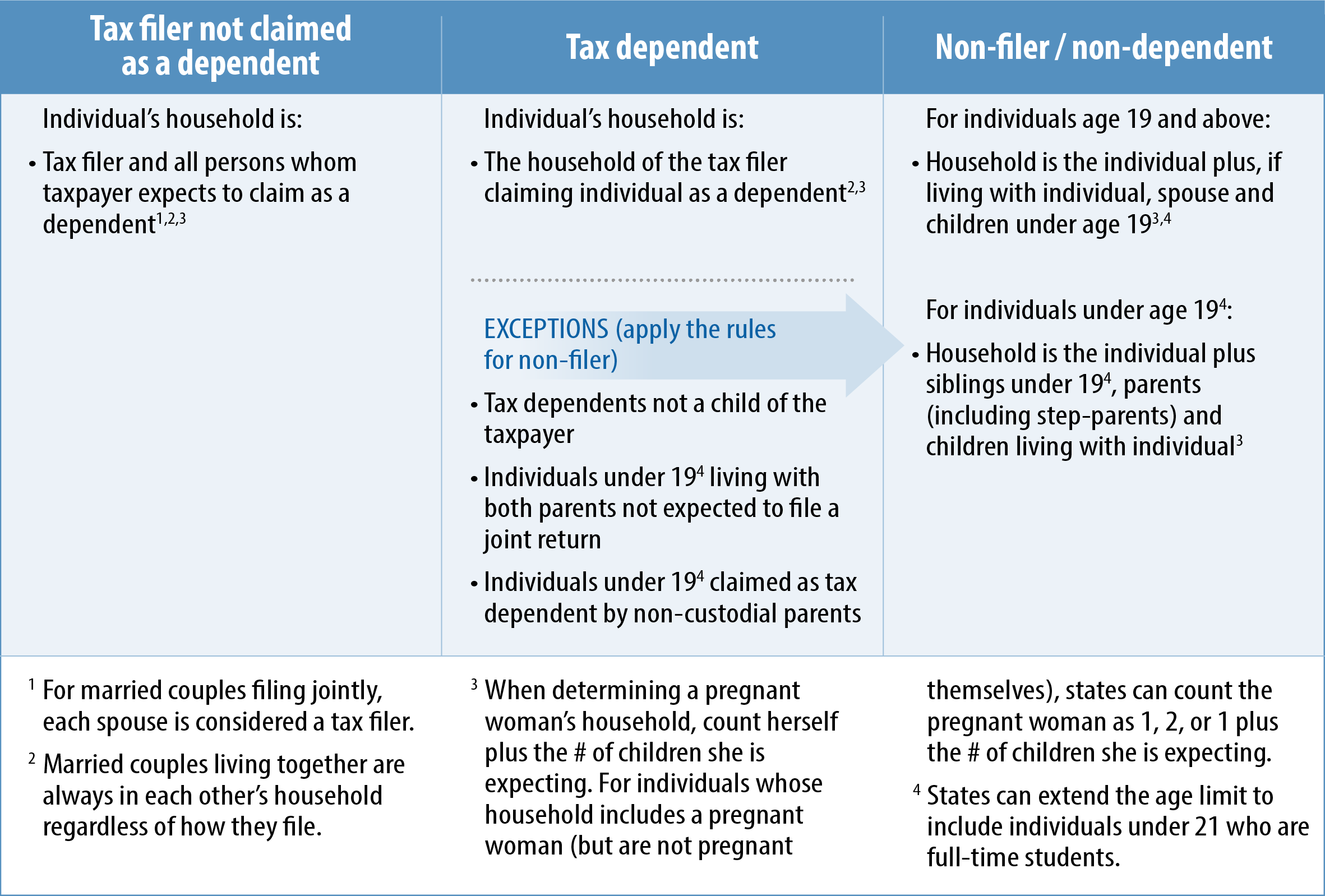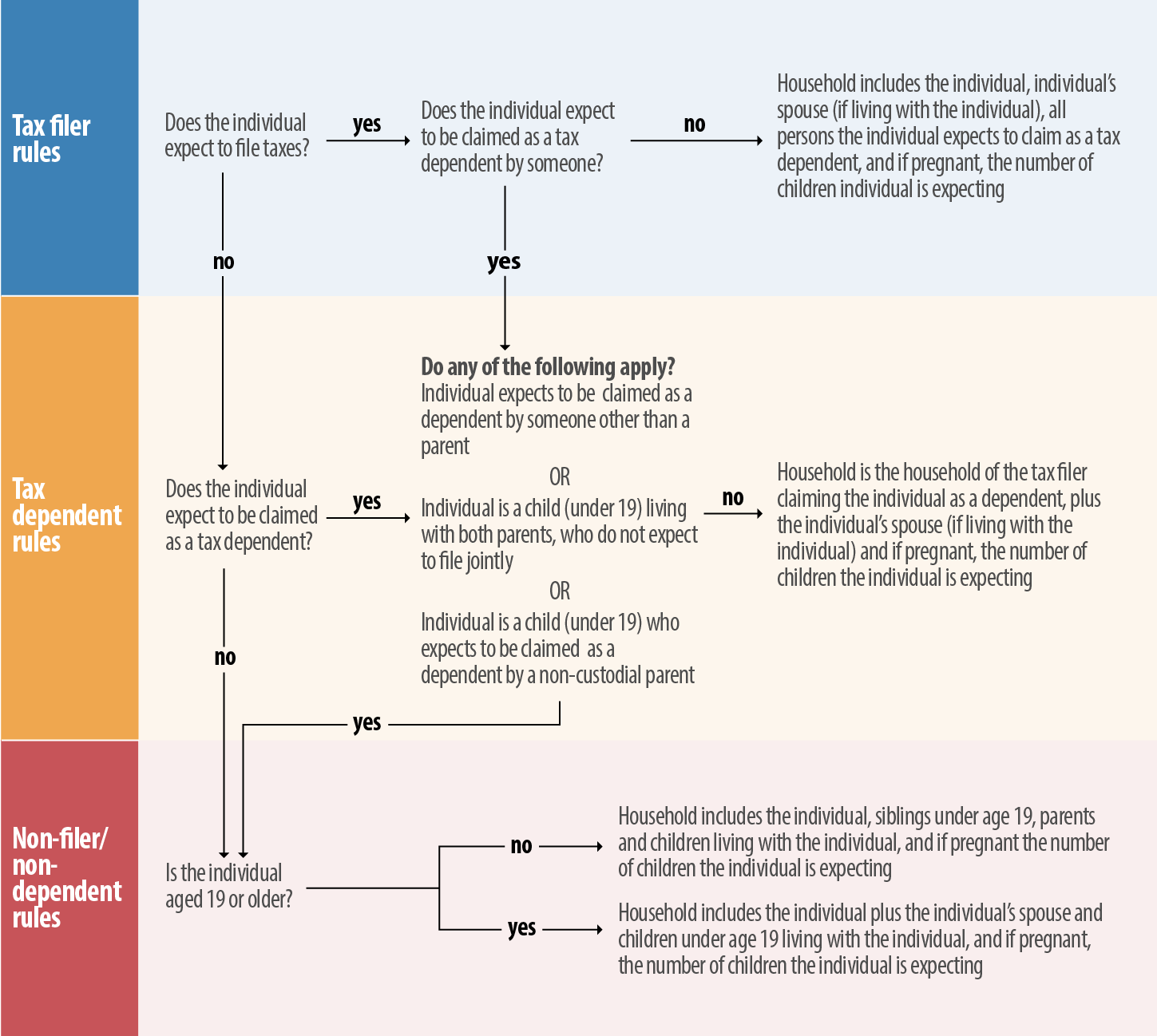Key Facts: Determining Household Size for Medicaid and the Children’s Health Insurance Program
Updated August 2020
Financial eligibility for most categories of Medicaid and the Children’s Health Insurance Program (CHIP) is determined using a tax-based measure of income called modified adjusted gross income (MAGI). The MAGI methodology includes rules prescribing who must be included in a household when determining eligibility. The following Q&A explains MAGI and the rules for determining Medicaid and CHIP households under MAGI.
What is MAGI?
MAGI is a methodology used to determine income for the purposes of Medicaid or CHIP eligibility. It is based on tax definitions of income and household. MAGI rules for determining what income to count when determining Medicaid, CHIP, and premium tax credit eligibility are mostly aligned. The rules determining who is in a household and whose income to count, however, can vary significantly. Also, under MAGI rules, an individual or family’s assets do not count in determining eligibility. (For more information on what income counts under MAGI rules, see Key Facts: Income Definitions for Marketplace and Medicaid Coverage.)
To whom do the MAGI rules apply?
All states must use the MAGI rules regardless of the decision to expand Medicaid. However, MAGI rules apply only to certain categories of Medicaid eligibility. These include parents and caregiver relatives, children, pregnant women, and the adult expansion group. States’ previous rules for determining income and households continue to apply to the elderly, disabled, and children in foster care.
How do Medicaid and premium tax credit household rules differ?
Medicaid and CHIP households are determined based on a person’s family and tax relationships as well as their living arrangements. How people file taxes and who is in their tax unit doesn’t always determine who is in their Medicaid household, but it determines which Medicaid household rules apply in defining the household. Premium tax credit household rules, on the other hand, are based purely on tax relationships.
The most important difference between Medicaid and premium tax credit households is that for Medicaid, household size and composition are determined separately for each member of the household, but for the premium tax credit, members of a tax unit are always treated as a household. This means that for Medicaid, household size may differ for family members even when they are in the same tax filing household. Thus, it is possible that for Medicaid, a family of three filing its taxes together may have two members with a household size of three and the third member of the family may be a household of one. For the premium tax credit, each member of a household that files its taxes together will have the same household size. (For more information on determining household size for the premium tax credit, see Key Facts: Determining Household Size for the Premium Tax Credit.)
Another important difference is Medicaid provides states with several options that affect how they define households when determining Medicaid eligibility. However, because the premium tax credit is a federal benefit, the rules are established at the federal level and are consistent across states.
How does Medicaid determine who is in a household?
Medicaid determines an individual’s household based on their plan to file a tax return, regardless of whether or not he or she actual files a return at the end of the year. Medicaid also does not require people to file a federal income tax return in previous years.
For each individual applying for coverage, Medicaid looks at whether he or she plans to be:
- a tax filer
- a tax dependent
- neither a tax filer nor a dependent
People’s intended tax filing status determines which Medicaid household rules apply in making the household determination. Figure 1 summarizes the Medicaid household rules and Figure 2 shows how to apply these rules. (For more information, see Reference Guide: Medicaid Household Rules.)
| FIGURE 1: MAGI Rules for Determining Medicaid and CHIP Households |
||
 |
||
| FIGURE 2: How to Determine An Individual’s Medicaid Household |
||
 |
||
What are the household rules for a tax filer?
For tax filers claiming their own exemption and who can’t be claimed as a tax dependent, the household includes the tax filer, the spouse filing jointly, and everyone whom the tax filer claims as a tax dependent.
What are the household rules for tax dependents?
For tax dependents, the household is the same as the tax filer claiming the individual as a tax dependent. However, there are three exceptions to this rule, when the rule for non-filers is applied:
- Individuals who expect to be claimed as a dependent by someone other than a parent;
- Individuals (under 19) living with both parents, whose parents do not expect to file a joint tax return; and
- Individuals (under 19) who expect to be claimed as a dependent by a non-custodial parent.
What are the household rules for people who neither file a tax return nor are claimed as a tax dependent?
For individuals who neither file a tax return nor are claimed as a tax dependent, the household rules differ based on whether the individual is an adult or a minor:
- For individuals 19 years and older, the household includes the individual plus, if living with the individual, his or her spouse and children who are under 19 years old.
- For individuals under 19 years old, the household includes the individual, plus any siblings under 19 years old, children of the individual and parents who live with the individual.
Are there any adjustments to the three rules based on people’s tax filing?
In addition to the general rules for determining household size, some rules apply in all situations:
- Married couples who live together are always counted in each other’s household regardless of whether they file a joint or separate return.
- Family size adjustments need to be made if the individual is pregnant. In determining the household of a pregnant woman, she is counted as herself plus the number of children she is expected to deliver.
What are different options that states have for implementing MAGI?
States have flexibility in how they implement the MAGI rules in two areas. First, in some instances the Medicaid household rules applied may depend on whether an individual is under 19 years old or not. Where the rules indicate an age limit, states have the option to extend that age limit to 21 if the individual is a full-time student. Second, for individuals whose household includes a pregnant woman (but are not pregnant themselves), states can count the pregnant woman as one, two, or one plus the number of children she is expecting.
Are married couples who file taxes separately considered to be in separate households?
Generally, no. Married couples who live together are always considered to be in each other’s household regardless of how they file taxes.
However, married couples who don’t live together and who file taxes separately will be considered as separate households.
How does Medicaid determine the household size of family members when the parents live together but are not married?
As long as both parents file taxes, non-married parents living in the same household would still use the rule for tax filers to determine each parent’s Medicaid household. This means their household includes themselves and anyone claimed as a dependent on their tax return.
However, a child under 19 living with non-married parents and being claimed as a tax dependent by one of the parents, would fall into the non-filer rule. Therefore, the child’s household size for Medicaid would include himself, both parents, and any siblings living with the child. For example:
- Dan and Jen live together with their two children, Drew and Mary. Because they are not married, Dan and Jen must file separate returns. Jen claims Drew and Mary as tax dependents on her tax return. Dan files as a single person and doesn’t claim any tax dependents. Table 1 illustrates the household size determination for each member of the family. To determine the household size for Dan and Jen, Medicaid would apply the tax filer rule and include everyone in each of their specific tax household. To determine the household size for Drew and Mary, Medicaid would apply the non-filer rule because they are children living with both parents who are not expected to file a joint return.
| TABLE 1: Example of Determining Households for Non-Married Parents |
|||||||
| Filing Status | Counted in Household | Household Size | Medicaid Rule Applied | ||||
| Dan | Jen | Drew | Mary | ||||
| Dan | Tax filer | X | 1 | Tax filer rule | |||
| Jen | Tax filer | X | X | X | 3 | Tax filer rule | |
| Drew | Tax dependent | X | X | X | X | 4 | Non-filer rule (exception) |
| Mary | Tax dependent | X | X | X | X | 4 | Non-filer rule (exception) |
How does Medicaid determine the household of an adult child who is claimed as a tax dependent by his parents?
The household of an individual who is at least 19 years old and is claimed as a tax dependent by his parents is always the same as the household of the parents claiming him. This is true even if the individual was much older, say 35 years old. For example, under some circumstances parents can claim their child who is 35 years old as a qualifying relative on their tax return. In this scenario, Medicaid would use the tax dependent rule for determining the household of this individual, which means his household would be the same as the household of his parent (the tax filer) claiming him as a dependent. The following examples illustrate how the Medicaid rules would be applied:
- Barry is 29 and is claimed as a tax dependent by his parents. His parents also claim Barry’s younger brother and sister, who are 15 and 17. When determining his household for Medicaid, Barry has the same household as the tax filer claiming him as a dependent, thus Barry would have a household size of five: himself, both of his parents, and his brother and sister.
- Carla is 28 years and lives with both parents who are married. However, her parents file separate tax returns and Carla’s father claims her as a dependent on his tax return. Even though Carla’s parents file separate returns, married people living together are always in the same household as their spouse. As a result, Carla’s father has a household of three: himself, his spouse, and Carla. This means that Carla also has a household of three.
Does the exception to the tax dependent rule for tax dependents who are not a child of the taxpayer only apply to adult tax dependents?
No. This exception also applies to minors claimed as a tax dependent by someone other than their parent. Anytime an individual — regardless of age — is claimed as a tax dependent by someone other than their parents, the non-filer rules apply in determining that individual’s household. For example:
- Leena lives with and is under the guardianship of her aunt. She is five years old and doesn’t have any siblings or parents living with her. Leena’s aunt claims her as a qualifying relative on her tax return. Leena is a tax dependent but she falls under one of the exceptions to the tax dependent rule because she is not the tax dependent of her parents. This means Medicaid will use the non-filer rules to determine her household, and as a result, Leena’s household consists only of herself.

